This project is a part of our shared program with Africa Sand Dam Foundation. Our team is pleased to directly share the below report (edited for clarity, as needed).
Welcome to the Community
Katalwa Jipe Moyo Self-Help Group was formed in 2009 and later registered in 2013. It currently has 24 female members, making it an all women's group. Most of the women are from Katalwa Village which has a population of 43 people. Their larger area is home to 2,256 people.
The average age of these women is 53 years, and their average household size is six.
Their main reason for forming was for social welfare activities, farm terracing, table banking and poultry keeping.
Water Situation
Water in most parts of Kitui County is collected from scoop holes in sandy riverbeds. There's no water flowing aboveground, but if community members dig deep enough they'll find it. This is no exception for the women of Katalwa Jipe Moyo, who walk to the Katalwa kwa Kutu River to fetch water for drinking, cleaning, cooking, and all other needs. However, they do have an unprotected shallow well located in the riverbed that gives them a select place to fetch water. When not being used, a cover is placed over the hole. When being used, a bucket is lowered for water and raised with a rope.
20-liter jerrycans are filled and transported on dokey or ox-drawn carts. Other households are able to afford motorbikes - people are getting really good at balancing heavy loads as they ride their motorbikes! But those who cannot afford any of the above must resort to hefting these heavy containers on their backs.
The unprotected well has a large contamination entry point at the hatch. This open well does not keep bugs or litter out of the water, and the bucket and rope themselves directly introduce new contaminants.
Rampant waterborne disease is a daily reality for people who rely on this dirty water for drinking. Any money that was saved from farming is instead used on treating these sicknesses.
Sanitation Situation
We were able to visit with Agnes Mwende and Tabitha Munywoki at their neighboring homesteads to talk about hygiene and sanitation in their community.
A little over half of households have at least some sort of pit latrine, though most of the lack doors and just have a curtain hanging in the opening. The materials used for the latrine walls depend on a household's economic status. But because so many people still don't have their own latrine, open defecation is an issue in this community. Waste left out in the open like this attracts flies that spread germs throughout the community, endangering all.
A handful of hand-washing stations were seen, along with dish racks and clotheslines for drying things safely off the ground. Half of households dispose of their garbage in an open area, while only a third have a pit.
As for water hygiene, 20 out of 23 people surveyed don't treat their drinking water.
Plans: Hygiene and Sanitation Training
To address gaps in hygiene and sanitation practices in Nzalae Community, training will be offered to self-help group members on three consecutive days. The members will learn about useful practices and tools to improve health, and then will be able to share those with their families and neighbors. Water transport, storage, and treatment methods will be taught, and hand-washing will be a focus. Group members will learn how to make their own hand-washing stations with everyday materials. To motivate participants, we must show the links between these activities and their people’s health. Open defecation certainly won’t be overlooked; everyone will be aware of how not using a latrine endangers the entire community. Since it's such an issue here, we will be leading the community through CLTS (community-led total sanitation).
Plans: Sand Dam
Members of this group heard about us from a neighboring self-help group that we are working with. They then approached our field officer with a request for support, and after verifying that they had the relevant registration documents, they were put on our mandatory six-month probation period. During this time, locals are expected to seriously take development to heart and begin constructing hygiene facilities and gathering local materials to be used in the construction process. After that, we returned to verify their water challenges and their need for additional support. The evidence to warrant our support was sufficient, and the group was taken on board. Their first proposed site for a sand dam was also approved by our technical team because there is firm bedrock and wide banks. It will be located in neighboring Nzalae Community, since this is actually most central for all self-help group members. This particular sand dam is projected to be 50.6 meters long and 4.25 meters high.
This sand dam will be one of many construction projects to come in the next few years. We will spend a total of five years unified with this community to address the water shortage. More sand dams will be built to transform the environment. As the sand dam matures and builds up more sand, the water table will rise. Along with these sand dams, hand-dug wells will be installed to give locals a good, safe way to access that water.
As the sand dam construction begins, community members will start excavating their first adjacent hand-dug well (click here to see that well project).
Agnes Mwende told us, "We have consumed dirty water all our lives. But this is a sure answer to better health and less waterborne diseases in our village. When we saw cement being delivered on site, we saw God. We can't be more grateful!"

 Sand Dam
Sand Dam
 Rehabilitation Project
Rehabilitation Project



































